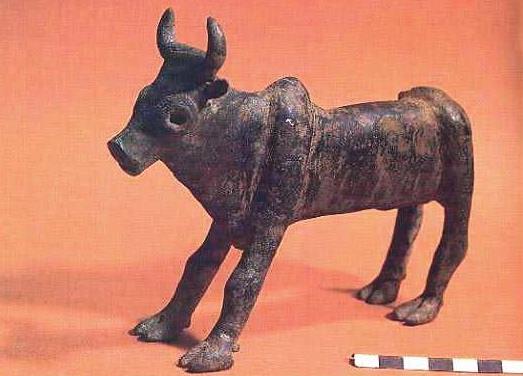Bronze Bull, c. 1200 BCE
A bronze bull statuette measuring 5” x 7” was found on the ground surface at a hilltop site near Dothan in northern Samaria. The hump-backed Zebu bull depicted, not native to the region of Israel, was portrayed in drawings and figurines from second and first millennium Mesopotamia, Anatolia (ancient Turkey), Syria, Lebanon, Cyprus, and Egypt. A bronze figurine comparable to the Bull Site example was found in a Late Bronze Age (ca. 1600-1200 BCE) temple at Hazor in northern Israel. The style of casting suggests northern manufacture, perhaps in Syria.
Canaanites of the Late Bronze Age, the period preceding the emergence of Israel, adopted the bull as symbols of their powerful male deities – to represent Baal and Hadad and as a title of El. The bull also served as the pedestal on which gods stood (or the image was placed) or as their throne. Bulls continue in this function, as divine thrones, into 9th c. Israel as demonstrated by the bronze plaque from Tel Dan depicting an unidentifyable deity perched atop a bull.
The Bull Site sacred precinct consisted of a stone border enclosing a 70-foot diameter elliptical circle. In addition to the bull, the enclosure contained a paving or platform of flat stones to level the bedrock and beside it a large, roughly hewn stone measuring 4 feet long, 3 feet high, and 1.75 feet thick. A piece of an Egyptian bronze mirror(?) and the ceramic base perhaps of an incense stand or miniature shrine lay nearby. Pottery in the vicinity dated the site to approximately 1200 BCE. Settlements in the surrounding area, all farmsteads, also dated to approximately 1200 BCE.
The Bull Site and Ancient Israel
The locale is an isolated hilltop in the central highlands near Mt. Gilboa, in the territory ascribed to the tribe of Manasseh. Both the bull figurine and the large stone, interpreted as a (reclining) standing stone (massebah) or an altar render the site cultic. Israelites and the Canaanites before them erected standing stones and worshipped deities in the form of a bull (or resting on a bull throne or pedestal). Israelite worship of bulls is known from the biblical accounts of the golden calf in the desert (Exodus 32), King Jeroboam of Israel erecting golden calves in his border temples at Dan and Bethel (I Kings 12-28-33; II Kings 10-29), and the prophet Hoshea’s condemnation of the idolatrous practice (Hoshea 8- 5-6). Standing stones were another standard feature of Israelite religious practice (eg. Jacob erects a stone, Gen 28-18) not forbidden until the religious reforms of King Hezekiah in the late 8th/early 7th c. (II Kings 18- 4).
We lack evidence to determine whether the people who worshipped at this shrine, identified as a biblical “high place” (bamah), considered themselves Canaanites, Israelites, or something else. Many scholars attribute the proximate farmsteads dated to approximately 1200 BCE to Israelite settlers and so consider the shrine to be Israelite as well. The Israelite attribution is based on the fact that the territory later belongs to Israel and an inscription by the Egyptian Pharaoh Merneptah, the “Merneptah Stele,” situates Israelites in the general region in 1207 BCE. However, both the cultic interpretation of the site with its scant finds and the identification of the nearby settlers are contested.
For further reading see the popular, illustrated account by A. Mazar, “Bronze Bull Found in Israelite ‘High Place’ from the Time of the Judges” BAR 9.5 (1983) 34-40 or the more technical account in “Bull Site” NEAEHL I- 266-67. Mazar responds to M. Coogan’s challenging the cultic identification in “On Cult Places and Early Israelites- A Response to Michael Coogan” BAR 14.1 (1988). For the Tel Dan plaque see A. Biran, “Two Bronze Plaques and the Hussot of Dan” IEJ 49 (1999) 54, fig. 14.
Elizabeth Bloch-Smith




